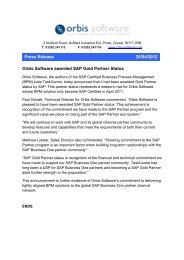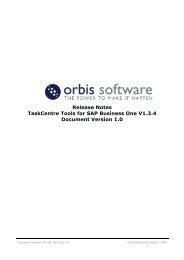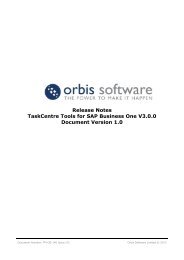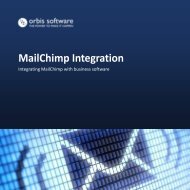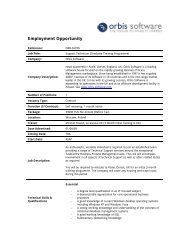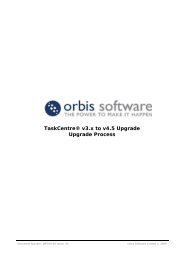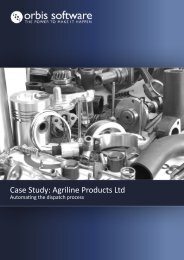Learn More - Orbis Software Ltd
Learn More - Orbis Software Ltd
Learn More - Orbis Software Ltd
You also want an ePaper? Increase the reach of your titles
YUMPU automatically turns print PDFs into web optimized ePapers that Google loves.
AUTOMATING CRM PROCESSES<br />
®<br />
TaskCentre<br />
Sales and Marketing Automation with Interactive<br />
Workflow - A Guide to Intelligent CRM.<br />
Customer: The Tie Company <strong>Ltd</strong><br />
Address 1: Not Entered<br />
Address 2: Not Entered<br />
County: Yorkshire<br />
Activity Date: When workload allows it<br />
Real-Time CRM<br />
®<br />
TaskCentre for CRM Solutions<br />
Delivering the untapped capabilities of your CRM application<br />
Business Application Enhanced<br />
The knowledge you will gain from this paper:<br />
Customer Relationship Management (CRM)<br />
Module<br />
Sales and Marketing Automation with Interactive<br />
Workflow<br />
Business Goal<br />
Increased Profits through Intelligent CRM<br />
⇒<br />
⇒<br />
⇒<br />
⇒<br />
⇒<br />
⇒<br />
A true clarification of what CRM professionals have been seeking for over 20 years.<br />
The problems that CRM professions commonly face and the historical strategies that companies have<br />
adopted in response.<br />
The emergence of Sales and Marketing Automation with Interactive Workflow technology for CRM<br />
applications and its empowerment of the CRM professional<br />
Real-life illustrations of TaskCentre® for CRM applications that will strike a chord with every CRM<br />
professional<br />
The business benefits of Sales and Marketing Automation and Interactive Workflow to the CRM<br />
professional<br />
A summary of the functionality available to the CRM professional
‘Sales and Marketing Automation with Interactive Workflow’ - A Guide to Intelligent CRM<br />
Introduction<br />
The competitive arena is evolving on a<br />
second-by-second basis and no<br />
company is free from the effect of<br />
commercial rivalry. Indeed, as Customer<br />
Relationship Management (CRM)<br />
professionals readily confess, the<br />
relentless jostling for the acquisition of<br />
new customers or the retention of<br />
existing clients has now become precise<br />
arts in their own right.<br />
Yet, throughout the evolution of CRM,<br />
one thing has remained true; the<br />
customer is king. Industrial analysts<br />
from both the technical and nontechnical<br />
arenas have predictably<br />
revamped this old-age marketing truth<br />
with phrases such as ‘Personalisation,’<br />
‘One-to-One Marketing,’ ’Customer<br />
Experience Management” and today’s<br />
latest mantra ‘Customer-Centric’<br />
marketing. Unfortunately, the fact<br />
remains that nothing has really changed<br />
in 20 or so years. It’s all about who can<br />
fulfil the customers needs cheaper,<br />
quicker and in the most personal,<br />
professional and intelligent manner.<br />
In pursuit of this Holy Grail of CRM,<br />
many organisations have deployed the<br />
powerful CRM application, SalesLogix<br />
and brought about greater structure,<br />
meaning and professionalism to the<br />
management of their customer<br />
relationships. Furthermore, CRM<br />
systems have facilitated strong business<br />
forecasting, increased accountability and<br />
visibility of the marketing department and<br />
made a solid contribution to<br />
organisational growth.<br />
Yet, although the success stories of<br />
CRM systems are well documented in<br />
industrial circles so is CRM’s achilies<br />
heel; its complete dependence on<br />
people.<br />
This guide seeks to highlight why the<br />
total reliance on the manual use of the<br />
company CRM system is resulting in a<br />
unnecessary risk to customer<br />
satisfaction, the loss of revenue and how<br />
the marketing automation and interactive<br />
TaskCentre Examples<br />
• Advanced Business Alerts: Be alerted when key data is altered,<br />
activities have not been completed, the price of your products<br />
change, product lines are out of stock, a key client does stops buying<br />
or when service levels are/are not achieving company targets.<br />
• Document Automation: Automate the construction and delivery of<br />
sales reports, KPI’s, weekly pipeline figures, account manager<br />
performance reports, introduction/welcome/upsell/cross-sell<br />
communications or customer documentation.<br />
workflow capabilities of TaskCentre®<br />
have made this solution a the ‘must<br />
have’ module for custodians of CRM<br />
application seeking CRM perfection.<br />
What’s your problem?<br />
Your problem is the same as it’s always<br />
been; The ever-increasing gap between<br />
the speed of commerce and the capabilities<br />
of your staff. This is showing no sign<br />
of decreasing and your company’s core<br />
business processes are coming under<br />
increasing scrutiny from key stakeholders.<br />
This is because people have physical<br />
limitations, make errors and suffer from<br />
imperfect knowledge. The volume of<br />
work that the average CRM function now<br />
processes outstrips the actual capabilities<br />
of the employee. Consequently,<br />
shortcuts are being made and your CRM<br />
investment is becoming increasingly<br />
underutilised.<br />
All-too-common examples that will strike<br />
a chord with companies using a CRM<br />
application include, users not creating a<br />
new client record, setting an activity,<br />
archiving sent and received e-mails,<br />
incomplete or incorrect data or simply<br />
not having enough time to identify important<br />
activities or records when contact or<br />
administrative tasks are required. The<br />
problems that are created from just<br />
these few examples are having a detrimental<br />
impact on the company’s commercial<br />
performance today.<br />
Another major issue for CRM professionals<br />
globally is the increasing disparity<br />
between the CRM user’s ability to fulfil a<br />
request for information and the<br />
expectations of customers.<br />
Your options<br />
There are four theoretical options open<br />
to the CRM professional who is seeking<br />
to address the problem of the rapid pace<br />
of commerce, expanding workloads and<br />
ever-increasing customer expectations.<br />
These are:-<br />
⇒ Employ more users to<br />
administer your CRM system<br />
⇒<br />
Extract more value out of<br />
your existing CRM users<br />
⇒ Do nothing and find better<br />
ways to ‘fire-fight’ issues as<br />
they arise<br />
⇒ Add marketing automation<br />
and interactive workflow<br />
capabilities to your CRM<br />
application<br />
Option 1: Employ more users to operate<br />
your CRM system<br />
If you have the luxury of capital available<br />
you could employ more CRM application<br />
users. The immediate benefit should be<br />
that your response times should<br />
decrease to the degree where you may<br />
achieve ‘near-time’ responses to<br />
customer requests and issues.<br />
Unfortunately, this approach of course is<br />
dependent on the availability of capital<br />
not only to employ more users but to<br />
provide them with sufficient training and<br />
ongoing support. Furthermore, there<br />
would be a user leaning curve and your<br />
company will have to purchase<br />
additional user licences which will need<br />
to be built into the planned expenditure.<br />
Tip<br />
Automate the protection of critical data or enforce company data entry<br />
rules for documents such as contact details, product pricelists or<br />
approved discount levels using TaskCentre’s SQL trigger, Query ODBC,<br />
Format at text and Send as SMTP.<br />
It should also be stressed that further<br />
CRM users will not address many of the<br />
fundamental issues facing the CRM<br />
professional.
‘Sales and Marketing Automation with Interactive Workflow’ - A Guide to Intelligent CRM<br />
For example, a new operative can be<br />
just as likely to make a data input error<br />
as those that preceded his/her arrival.<br />
Furthermore, customers expect real-time<br />
responses and interactions with your<br />
company and only event-driven, selfhandling<br />
infrastructures can deliver this.<br />
People have physical limitations.<br />
Finally, who will monitor and report on<br />
that performance of your marketing<br />
activities and your CRM application<br />
users? Does your company harbour a<br />
manager with sufficient time to spare to<br />
create and distribute increasing numbers<br />
of reports or statistics?<br />
Realistically, employing more CRM<br />
users is a short-term, limited response to<br />
a more complex problem.<br />
Option 2: Extract more value from your<br />
existing CRM application users.<br />
It is widely accepted that 99% of all<br />
application users could increase their<br />
capabilities and/or output through<br />
additional motivation and training.<br />
Indeed, many research papers have<br />
shown that with the right blend of<br />
managerial motivation and on-going<br />
training, greater efficiencies can be<br />
achieved throughout the CRM function<br />
and indeed the wider organisation.<br />
Once again, you may be able to instil<br />
better CRM practices and generate<br />
higher standards of CRM but does<br />
extracting more from your user address<br />
all the issues facing the CRM<br />
professional? No.<br />
The law of diminishing returns dictate<br />
that there becomes a point where an<br />
input (additional training or a new<br />
member of staff) will deliver less value<br />
than the input that preceded it.<br />
Furthermore, even in smaller<br />
organisations better training and<br />
motivation does not and cannot satisfy<br />
the customer’s growing need for realtime,<br />
personal interaction with your<br />
company.<br />
Better trained and motivated users do<br />
Tip<br />
TaskCentre Examples<br />
• Subscriptions & Request: Enable property seekers to request<br />
property details by sending an SMS text message to a short code<br />
placed on a For Sale board or facilitate automated news subscription<br />
services so that your customers/trading partners receive business<br />
information as it happens.<br />
• Integration: Connect all the company’s applications so that financial<br />
data can be passed from remote office application and automatically<br />
written into the primary accounting solution or facilitate the automatic<br />
archiving of e-mails within a specific business application.<br />
not fully address the ever-increasing<br />
workloads that are prevalent throughout<br />
many organisations. For instance, how<br />
many times has your organisation failed<br />
to send the appropriate service/<br />
contractual renewal documents to clients<br />
within the specific time period? <strong>More</strong><br />
importantly, how would you know if a<br />
CRM user had not done this! The<br />
answer is simple, you wouldn’t. It’s<br />
physically impossible to manually<br />
monitor every action of your CRM users.<br />
Option 3: Do nothing and find better<br />
ways to ‘fire-fight’ issues as they arise.<br />
Unfortunately, due to the evolution of<br />
CRM applications and the financial<br />
realities for the vast majority of<br />
organisations throughout the UK, the<br />
industry is littered with illustrations of<br />
instances where organisations have<br />
established ‘steering groups’ or<br />
‘management teams’ to deliver reports or<br />
KPI’s on the company’s performance for<br />
a given time period. Yet, in reality, all<br />
these groups are actually doing is ‘firefighting’<br />
or ‘reporting’ the symptoms of a<br />
much more complex problem. Yes,<br />
senior decision-makers may react to<br />
these reports by refocusing the efforts of<br />
the CRM team on one or two specific<br />
areas but is this not the CRM equivalent<br />
of ‘take from Peter, give to Paul’?<br />
In short, fire-fighting, as we call it, has<br />
been blended with options one and two<br />
over the years in an attempt to resolve<br />
the fundamental issue that has been<br />
plaguing the CRM professional for years;<br />
vanilla CRM applications are reliant<br />
on the user to extract and deliver<br />
value.<br />
Take the wasteful administration out of CRM by automating reports such<br />
as the daily/weekly/monthly sales pipeline, number of calls made by<br />
CRM users, revenues for the day/week/month or product line<br />
profitability. Also set up real-time exception reports for hotspot issues.<br />
Fire-fighting is not a long-term, intelligent<br />
answer to the complex problems facing<br />
the CRM professional. It can help to<br />
resolve short-term, operational/tactical<br />
issues but ultimately it is a reaction to a<br />
historical event.<br />
Option 4: Add sale and marketing<br />
automation and interactive workflow<br />
capabilities to your CRM application.<br />
The marketing automation and<br />
interactive workflow is rapidly becoming<br />
the most talked about approach to CRM<br />
by industrial analysts and CRM<br />
professionals alike. But what exactly is<br />
marketing automation and interactive<br />
workflow?<br />
These two functional capabilities are the<br />
broad sweeping business benefits<br />
achievable through the addition of a<br />
Pure-Play Business Process<br />
Management (BPM) solution to CRM<br />
applications.<br />
Through a simple drag and drop planner,<br />
CRM professions can use BPM tools to<br />
strategically automate business process<br />
in line with company rules and<br />
procedures. Indeed, it is this flexibility<br />
and the power of BPM tools that drive<br />
CRM vendors to partner with ‘pure-play’<br />
BPM vendors and their solutions.<br />
To illustrate marketing automation more<br />
clearly, lets consider an example: A<br />
typical machine servicing company.<br />
Each day, week or month its clients<br />
approach the end of their contractual<br />
agreement with the given company.<br />
In response to this typical customer<br />
lifecycle, a company CRM user sends<br />
out renewal contracts on key dates until<br />
the contract is about to lapse. Each<br />
communication could harbour a sliding<br />
time-based discount.<br />
To support the above, the CRM user
‘Sales and Marketing Automation with Interactive Workflow’ - A Guide to Intelligent CRM<br />
archives all his/her e-mails and sets an<br />
activity for a follow-up call.<br />
By adding sales and marketing<br />
automation capabilities to CRM<br />
applications, the only activity the<br />
company would have to make would be<br />
the follow-up call. Everything else from<br />
renewal identification, document<br />
creation, customer communication,<br />
archiving and activity setting would be<br />
automated. No client would ever miss an<br />
offer of renewal and, if required,<br />
automated reports on activities<br />
completed/uncompleted can be sent to<br />
line managers.<br />
Interactive workflow is the functional<br />
capability that CRM professionals have<br />
been demanding for years and through<br />
BPM technology, this need is now being<br />
met.<br />
To illustrate how interactive workflow can<br />
help CRM users, lets continue with the<br />
example of the machine servicing<br />
company.<br />
Like most commercial enterprises today,<br />
the company’s web site offers potential<br />
clients the opportunity to download<br />
documents, such as brochures or price<br />
lists, in return for entering their details<br />
within a form.<br />
Following this event/download, the CRM<br />
user would manually enter the<br />
information into the CRM application,<br />
possibly send a polite introduction/<br />
welcome e-mail/letter and then set an<br />
activity to follow up.<br />
By adding interactive workflow<br />
capabilities to the CRM application, this<br />
entire process can be automated and<br />
enhanced. For instance, once the web<br />
visitor has submitted their details,<br />
TaskCentre would automatically capture<br />
the information, create a new record (or<br />
add a new contact to a record if the<br />
record already exists), send out and<br />
archive an introduction/welcome e-mail/<br />
letter and set a follow-up activity.<br />
TaskCentre Examples<br />
In above addition to the above, your new<br />
CRM application module could<br />
automatically distribute e-mails, inclusive<br />
of smart tags, to senior decision-makers<br />
so that they can drill down into the new<br />
account. No manual intervention would<br />
be required thus ensuring complete<br />
compliance to company protocols.<br />
The illustration is just one very basic<br />
example of what marketing automation<br />
and interactive workflow module can<br />
deliver to your company.<br />
Business Benefits<br />
The business benefits that marketing<br />
automation and interactive workflow<br />
technology can deliver your company<br />
are both generic to your CRM application<br />
and specific to your industry. However,<br />
below are just few examples of what this<br />
technology can provide to your<br />
company:-<br />
⇒ Higher customer acquisition<br />
and retention rates<br />
⇒ Intelligent complaints handling<br />
⇒ Better customer lifecycle<br />
management<br />
⇒ Eradication of the company’s<br />
⇒<br />
⇒<br />
⇒<br />
⇒<br />
• Web Content Publishing: Automatically FTP new product prices to<br />
the company web site, a product order and delivery details to an<br />
intranet for warehousing and logistics, account managers’ sales<br />
performances into a secure extranet and real-time service levels to<br />
an intranet for the telesales management team.<br />
• Workflow: Never have to enter a web site generated lead in to your<br />
CRM system again, enable employees to dynamically receive<br />
documentation for their contribution or increase the visibility of<br />
account changes via e-mails that harbour smart tags.<br />
manual<br />
processes<br />
administrative<br />
Event-driven marketing<br />
Self-handling infrastructure that<br />
delivers true, real-time CRM<br />
performance<br />
Reduced operational costs<br />
<strong>More</strong> effective use of your most<br />
important resource, your<br />
employees.<br />
⇒ Policing, protection and<br />
enforcement of company data<br />
policies<br />
⇒<br />
Increased visibility of employee<br />
or company performance<br />
through automated reporting<br />
and dynamic workflow<br />
⇒ Failure avoidance through<br />
exception reporting<br />
⇒ Automated handling of<br />
‘unsubscribes’ from e-mail<br />
campaigns<br />
The list of business benefits that<br />
marketing automation and interactive<br />
workflow can deliver is endless and the<br />
examples to the left are just a small<br />
sample of what you could achieve<br />
through TaskCentre’s BPM tool kit.<br />
Need <strong>More</strong> Information?<br />
To learn more about TaskCentre, its<br />
technical features and the experiences<br />
of other companies who currently utilise<br />
TaskCentre’s Business Process<br />
Management Solutions please visit:<br />
www.orbis-siftware.com<br />
or call us on: 01202 241115 now<br />
Tip<br />
Give your stakeholders real-time, automated access to the reports they<br />
need such as delivery times, products purchased, order status update or<br />
trading partner status through TaskCentre’s SMS or SMTP triggers.
‘Sales and Marketing Automation with Interactive Workflow’ - A Guide to Intelligent CRM<br />
About the Company | <strong>Orbis</strong> <strong>Software</strong><br />
<strong>Orbis</strong> <strong>Software</strong> provides the leading pure-play Business Process Management and Workflow solution,<br />
TaskCentre, enabling organisations to drive efficiency and reduce costs through collaborative process<br />
automation.<br />
Founded in 1997, <strong>Orbis</strong> <strong>Software</strong> <strong>Ltd</strong> provides a scalable suite of applications to suit any size of organisation.<br />
There are more than 4000 organisations around the world already using <strong>Orbis</strong> products, including such names as<br />
Nasdaq, Telstar, BP, BDO Stoy Hayward, GE Capital Equipment, The Rank Group, Salomon Brothers, Zenith,<br />
BUPA, Jaguar, Lloyds TSB, and Rolls Royce.<br />
© 2006 <strong>Orbis</strong> <strong>Software</strong> <strong>Ltd</strong><br />
For further information please contact:<br />
<strong>Orbis</strong> <strong>Software</strong>,<br />
25 Bourne Gate,<br />
Bourne Valley Road,<br />
Poole,<br />
Dorset,<br />
BH12 1DY.<br />
Tel: 01202 241115<br />
Fax: 01202 241116<br />
Web: http://www.orbis-software.com




